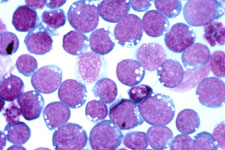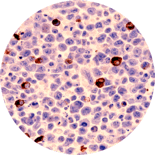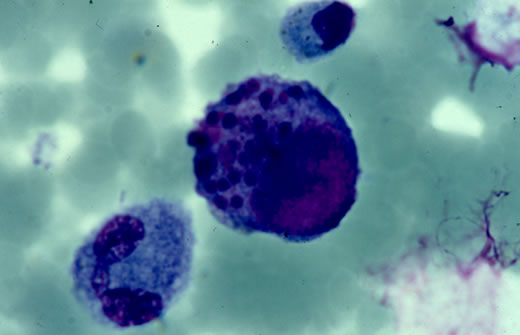
Epstein-Barr virus is prevalent in the world, with 95% of adults in the United States having been infected by age 40. This virus is the agent responsible for the “kissing disease,” otherwise known as infectious mononucleosis, which results in 35-50% of infected young children/adolescents. The incubation period for the virus is anywhere from four to six weeks, and the most common symptoms are fever, sore throat, and swollen lymph glands. Occasionally, the virus can cause a swollen spleen and or liver problems, and it has, on rare occasion, been found to induce cardiac and nervous system disorders. The symptoms usually last for up to four months, though there have been cases where the disease persists for over six months. This would then be classified as chronic EBV infection.
Once an individual is infected with EBV, the virus will persist in a dormant state in the blood, throat, and B cells for the rest of the person’s life, reactivating occasionally and being shed in the saliva in otherwise healthy individuals. Because of this, EBV transmission is almost impossible to prevent, and treatment for those with EBV infection is generally supportive. Steroids have been prescribed to reduce swelling, but otherwise, no medication exists. While death from infectious mononucleosis is extremely rare, EBV has been implicated for being associated with Burkitt’s lymphoma and nasopharyngeal carcinoma, cancers which are not usually in the US. The reason for the association is believed to be the fact that EBV immortalizes B cells, which leads to oncogenic potential.
Reference: http://www.cdc.gov/ncidod/diseases/ebv.htm
Picture: http://www.genomenewsnetwork.org/articles/2004/04/30/epstein_barr.php
Kaposi’s sarcoma-associated virus (HHV-8) is the newest herpesvirus to be discovered. It is a gamma II herpesvirus, and the first member of that genus known to infect humans. Unlike most herpesviruses, KSHV is not a ubiquitous infection in the general population, though it has been found in a high proportion of semen samples from homosexuals, leading to the hypothesis that the virus could potentially be sexually transmitted. It is also hypothesized that, like other herpesvirus, KSHV will endure in the host as an ongoing latent infection.
KSHV has been found not only in homosexuals, but in AIDS patients with Kaposi’s sarcoma, as well as body cavity based lymphomas (BCBL) and multicentric Castleman’s disease (which is a disease that is related to the development of Kaposi’s sarcoma). In the Kaposi’s sarcoma lesions, the virus has been found to infect the spindle and endothelial cells. It has also been found in circulating B cells in 50% of HIV positive individuals, and HIV positive homosexual men have been found to seroconvert for HHV-8 right before the onset of Kaposi’s sarcoma. For these reasons, it has been hypothesized that KSHV either has the ability to directly cause Kaposi’s sarcoma, or is at least a co-factor towards development. One hypothesis explaining the mechanism is that KSHV infects B cells, which then produce cytokines that cause the proliferation of resting endothelial cells, which then transform into the spindle cell phenotype found in Kaposi’s sarcoma lesions.
Reference: http://www.pubmedcentral.nih.gov/articlerender.fcgi?artid=379571
Picture: http://www.abionline.com/products/antibodies/specs/13214.htm
Cytomegalovirus is found worldwide, though it is more common in developing nations, as well as areas with lower SES. In the US in particular, 50-85% of adults will be infected by age 40. For individuals who are infected after birth, there are rarely symptoms. Only occasionally will the virus induce mononucleosis-like syndrome, prolonged fever, and or mild hepatitis. Otherwise, once the individual is infected, the virus will remain dormant, and for most people, recurrent infections will not develop.
However, the grave exceptions to the rule are unborn babies, as well as immunocompromised individuals. The latter includes organ transplant recipients, as well as AIDS patients. For immunocompromised individuals, the virus is able to reactivate, which can lead to diseases such as CMV retinitis. For unborn babies, CMV infection is one of the most important causes of congenital birth defects if the mother contracts a primary infection. The virus can lead to death for the fetus, or cause deformities such as mental retardation or hearing loss.
While there is no treatment for CMV, a vaccine is currently being tested. The best method at preventing transmission by far is hand washing, as the virus is not very contagious and can be easily removed with soap and water. However, for the immunocompromised individuals, there are several drugs which are used to control the progression of the disease. An example is ganciclovir, which is used to control CMV retinitis.
Reference: http://www.cdc.gov/ncidod/diseases/cmv.htm
Picture: http://lbmi.org/images/LBMIpathologyimages/Cytomegalovirus-tumb.jpg


